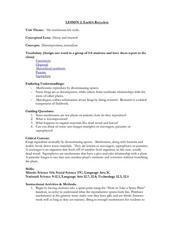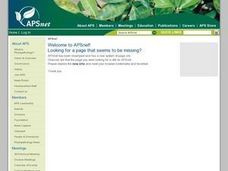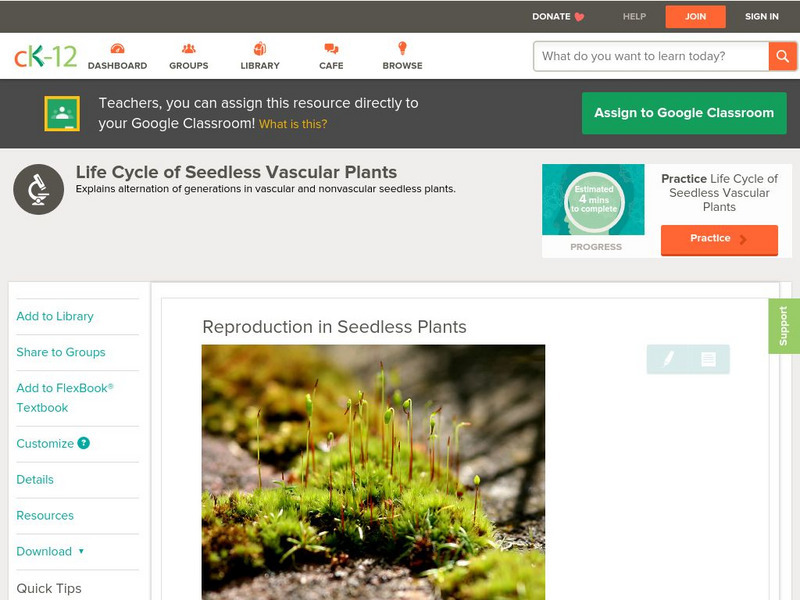Curated OER
Fungi
The general characteristics that affect the classification of fungi and other organisms in the domain Eukarya are detailed on 12 attractive slides. Teachers can access individual slides to cover life cycles or diversity, or can use the...
Curated OER
Don't Wait, Just Propagate
Students explore the process of growing plants from seed. In this propagation activity, students examine methods of propagation and determine how to rapidly propagate plant species. Students listen to a lecture informing them on the...
Curated OER
Sponges - A Coloring Worksheet
In this sponges worksheet, students read the information about sponges. Students answer the provided questions about the reading passage. Students color the illustration at the bottom of the page.
Curated OER
Sorting
Students identify how objects can be sorted or classified for easy access. In this sorting activity, students will investigate how letters, numbers, and symbols are used in sorting and classifying.
Curated OER
Population Growth
Learners grow duckweed, observe what happens when an organism population is allowed to grow without predation or competition, view videos about invasive species, and develop a proposal for controlling the growth of an invasive species in...
Curated OER
Vegetative Propagation Project
Learners, in this project, successfully start new plants by various means of vegetative propagation.
Curated OER
Fungi Crossword
In this biology worksheet, students complete a crossword puzzle with 28 questions about fungi. They identify the different parts of a fungus.
Curated OER
Steps for Taking a Cutting for Your Own Forest at Home
Young scholars study renewable and nonrenewable resources and take a hardwood cutting. In this hands on activity students learn what rooting hormones are, how they generate roots and then take their own cutting and root...
Curated OER
Determining the Effectiveness of Handwashing
Students participate in an experiment in which they grow bacterial colonies. They examine the effects of antibiotics killing the germs. They discuss their findings to end the lesson.
Curated OER
Fungus
Students study fungus, its reproduction and uses. In this eukaryote lesson students complete several fungal experiments.
Curated OER
Life Cycles of Mosses, Ferns, and Conifers
In this plant life cycle worksheet, students compare the life cycles of mosses, ferns, and conifers. This worksheet has 15 fill in the blank and 10 short answer questions.
Curated OER
Mitosis and Meiosis
Students model and differentiate between the processes of mitosis and meiosis. In partners, they use yarn and construction paper to create models for each of the phases of mitosis and meiosis then compare the chromosome numbers in each...
Curated OER
Earth's Recyclers
Students work together in groups to report on different topics related to decomposition. They answer questions and share their answers with the class. They discuss any topic that is unclear.
Curated OER
Kingdom: Fungi
The general characteristics of fungus types are presented here. Your class will love the pictures of the amazing features found on these strange living things. The internal and external structures and their functions are highlighted. By...
Curated OER
Where It Comes From: All About Heredity
Characteristics are not only inherited, but can be acquired through interactions with the environment.
Curated OER
COMMON KINDS OF INSECTS
Students will recognize and name three common insects.1. Share background information with students. 2. Provide students with the "bug body" puzzle pages, and have them cut the puzzles out.1. Share background information with students....
Curated OER
Water Molds (Oomycetes)
Students explore a group of fungus-like organisms; the Oomycetes, by baiting them from natural sources (water and soil) and observing them.
BiologyWise
Biology Wise: Asexual Reproduction in Plants
Explains the different ways that asexual reproduction can take place in plants.
Mocomi & Anibrain Digital Technologies
Mocomi: Reproduction in Plants
Discusses reproduction in plants either sexual or asexual and describes reproduction parts and pollination.
Biology Pages
Kimball's Biology Pages: Asexual Reproduction
Site from Kimball's Biology Pages provides information on Asexual Reproduction in plants, and also in animals, where it is less common. Includes information on stems, leaves, roots, plant propagation and apomixis.
BiologyWise
Biology Wise: Advantages of Asexual Reproduction
Describes some advantages to asexual reproduction.
Biology Pages
Kimball's Biology Pages: Asexual Reproduction
Everything you've ever needed to know regarding asexual reproduction. Modules include Asexual Reproduction in Plants, Asexual Reproduction in Animals, Why Choose Asexual Reproduction? Materials can be used as supplemental resources or as...
CK-12 Foundation
Ck 12: Life Science: Reproduction in Seedless Plants
[Free Registration/Login may be required to access all resource tools.] Seedless plants can reproduce asexually or sexually. Some seedless plants, like hornworts and liverworts, can reproduce asexually through fragmentation. When a small...
McGraw Hill
The Mc Graw Hill Companies, Inc.: Asexual Reproduction
The succinct site covers what asexual reproduction is in plants, describes how stolons and rhizomes produce new plants, and discusses human cloning techniques.




















